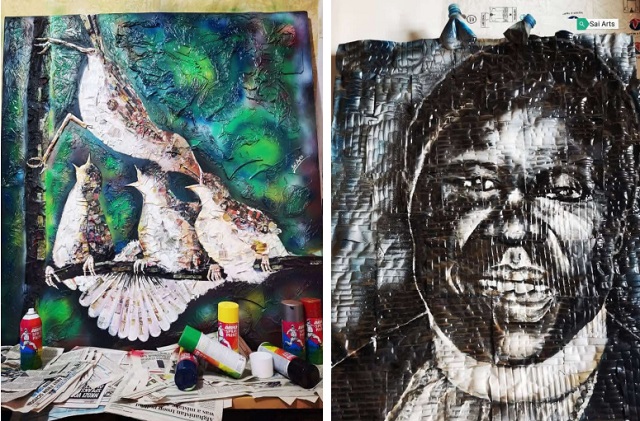
Multi-disciplinary artist, Sai works with degradable waste to build conversations about his community
| DOMINIC MUWANGUZI | Much has been said about Recycled art cleaning up the environment of waste and garbage and providing livelihoods to a number of artists since its inauguration in the mid-20th century. However, little is mentioned on how it contributed to the evolution of society and art. The latter can be argued to be the primary motivation for artists who are looking far beyond these obvious benefits. Artist, Simon Peter Sai based in Gulu in northern Uganda, is using recycled art to experiment with different techniques and themes in art. The multidisciplinary artist working in painting, installation and collage uses a host of non-degradable material including fabric off-cuts, polythene bags, metal scrap and car batteries to create assemblage portraits and abstracted images of social cultural lifestyle.
His portraits of iconic human figures like Betty Bigombe- the leading advocate of human rights during the LRA war- Nelson Mandela, Julius Nyerere and Arch. Bishop Janan Luwuum, suggest a deeper passion to explore the images beyond the theme of the human form that usually underline portraiture. Beneath such startling artworks is the urgency to communicate the humanitarian and revolutionary characteristic of these individuals. The integration of newspaper clippings as collage doesn’t only contribute to the aesthetics of the painting but conceptually, creates instant relevance of the subject to the viewer. Newspaper prints and magazines have over the years been integrated in artworks to achieve the latter effect.
Furthermore, the use of these recyclable objects is a representation of the nature of Acholi society in a post-civil war era. After going through a period of physical and emotional loss in the 1990s, the community has embarked on a rebirth process to heal from the past. The artist metaphorically responds to this process of rebirth through working with discarded objects. Like the lives of the Acholi that need to be given a new meaning outside the episodes of trauma and consequently self-pity, the artist repurposes the scrap objects. He picks them from the scrap fields and integrates them in his artworks to give them a new life and identity. The outcome of such creative engagement is the production of art that is both therapeutically and environmentally conscious.

In working with waste material, Sai a drop out student of Business Administration at Gulu University has positively impacted his life and that of his immediate community. His artistic undertakings have definitely revolutionized the manner in which the community perceives itself without feeling inadequate amidst scarce resources. The fact that the art genre is inexpensive to venture in with readily available materials to work with, this has inspired several youth to venture into related creative activities. It has also opened up possibilities of expression for the many youth; especially school drop outs and those who cannot find employment in a competitive job market.
But profoundly, the enterprise provides hope as reflected in the effervescent portraits of revolutionary figures. With the sharp irony of finding hope and freshness in discarded objects, the art provides the artist and his immediate community enormous opportunities to overcome the stereotyped identity of a society that is stuck in its past.
****
Sai Arts is located in Gulu City, in the northern region of Uganda. Images are courtesy of the artist.
 The Independent Uganda: You get the Truth we Pay the Price
The Independent Uganda: You get the Truth we Pay the Price



